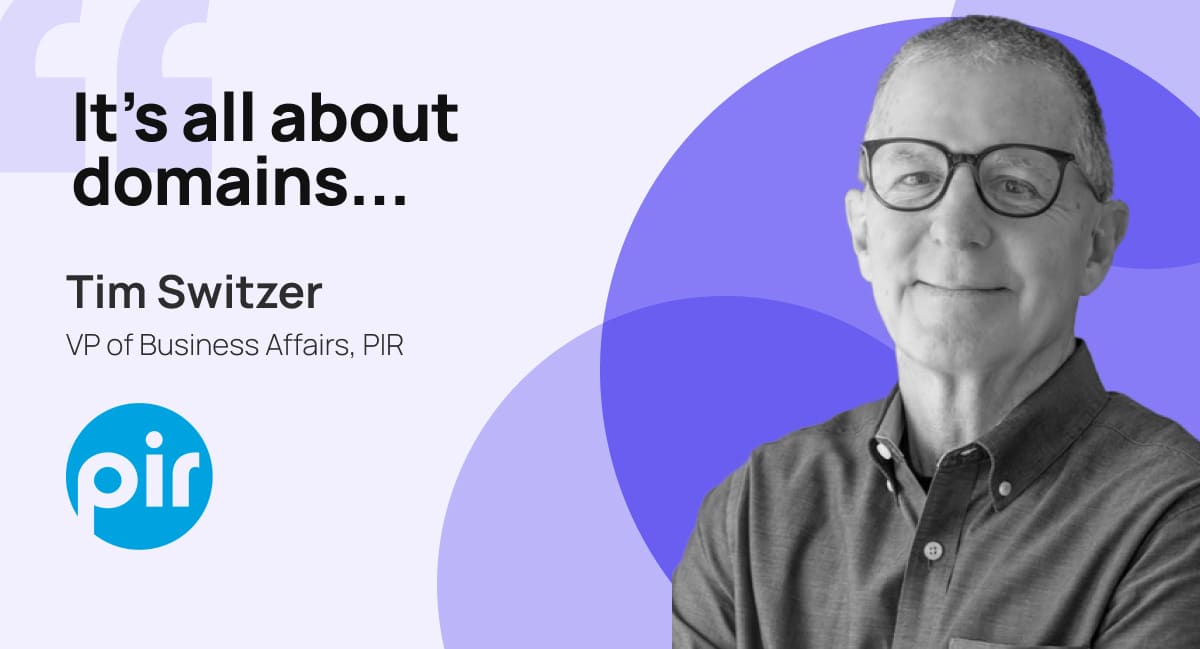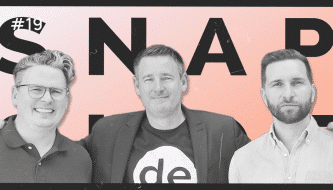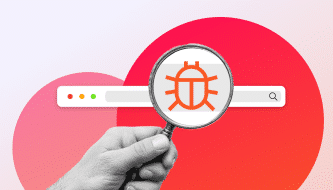
It’s all about domains with… Tim Switzer (PIR)

Where purpose meets the internet: Unveiling .org as a trusted space for nonprofits, changemakers and communities driving meaningful impact worldwide.
Published by

Simone Catania
Date
In the vast digital landscape, domain names serve as cornerstones for identity, guiding users to endless possibilities. Among these, .org stands out as a beacon for non-profits, NGOs and mission-driven organizations. As one of the legacy gTLDs established in January 1985, .org has evolved into a trusted digital space, synonymous with community-focused initiatives. With over 11 million registered domains globally (source: Global Domain Report 2025), it stands as one of the most widely registered TLDs.
The Public Interest Registry (PIR), stewarding .org since 2003, plays an instrumental role in its ongoing evolution. We’re thrilled to welcome Tim Switzer, the Vice President of Business Affairs at PIR, a seasoned leader with over two decades of experience shaping the domain space. From his tenure at Neustar and Verisign to leading roles at DotGreen, Tim has been a driving force behind major innovations in channel relations, operational strategy and domain growth. What’s more, his commitment to community extends beyond the digital world—using his passion for biking to support causes like Bike to the Beach, an awareness initiative for autism and disabilities.
As we explore everything from the evolution of .org to its role in empowering global organizations, Tim brings unmatched insight, industry context and a fresh perspective to the conversation. Dive in as we uncover the future of .org and what it means for today’s digital identities!

1 Let’s delve into the rich history and ongoing evolution of .org. How has .org’s purpose and positioning adapted over the years?
The extension .org is one of the legacy TLDs established in 1985. For more than 40 years, .org has conveyed trust, credibility and security. It’s the extension most commonly associated with global nonprofit organizations, companies, groups and individuals dedicated to making the world a better place.In its 40 years, .org has evolved into a global platform for social impact.
Today, the TLD is managed by the nonprofit Public Interest Registry (PIR), an organization whose mission is to be an exemplary domain name registry and serve the public interest. As a nonprofit ourselves, PIR was created by the Internet Society (ISOC) to manage, enhance, and expand the .org namespace. Today, 60% of the proceeds from each .org domain registrations contributes directly to ISOC’s efforts to maintain an internet that is open, free and accessible to all.
With over 11 million domain names registered worldwide, .org has built an enduring legacy of trust, empowering changemakers to harness the power of the internet to spread their missions. Since its inception in 1985, .org has empowered and mobilized over millions of websites and has become the home for some of the world’s most influential charities, associations, corporations, startups, social good businesses and civic groups.
If someone has a mission and wants to make a positive impact in the world, .org is the place to do so!
2 How does your team ensure it meets the diverse and evolving needs of organizations and individuals from various sectors?
The extension .org is an open TLD that is traditionally associated with nonprofit organizations, causes and communities. The diversity of this community is what makes it great. No one .org is the same and each. This extension is having an impact in its own, unique way. Through our various marketing initiatives we are building a network where these organizations can connect and share their own challenges and how they are overcoming similar issues – such as how to boost fundraising in difficult times.
We know that one of the best ways PIR can support the .org community is by providing a platform they can trust to enhance their mission and reach their audiences. That’s why protecting the .org space from DNS abuse is one of our highest priorities. Beyond just operating .org securely, we’ve taken a leadership role in the broader internet community— shaping industry best practices across the ICANN space in the areas of security, privacy and anti-abuse – in an effort to raise standards for everyone. For any organization online, domain security is important—but for the .org community, it’s absolutely critical.
By staying true to this mission, .org has continued to grow responsibly while maintaining the lowest abuse rates of all major gTLDs.
3 What measures does PIR take to ensure the security and integrity of .org domains?
At PIR, we believe trust and safety are essential for mission-driven work to thrive and we put a lot of focus on protecting the security and integrity of .org and the Family of Domains that includes .charity, .foundation, .gives, .giving, .ngo, and .ong. While we take all security threats very seriously, two initiatives that address threats specific to those vulnerable online and DNS abuse are worth highlighting.
Find perfect domains
- Back in 2018, we partnered with the Internet Watch Foundation (IWF) specifically to help protect .org, using tools to detect and disrupt child sexual abuse material (CSAM). In the five years before working with IWF we had only 4 URLs sent to us where people claimed there was CSAM. In the 5 years since working with them, IWF identified over 5,700. So it’s not that it wasn’t there – we just didn’t have the tools to identify it until we started working with IWF. In 2024, we expanded that partnership to serve the broader internet community, sponsoring free access to IWF’s Domain Alerts and TLD Hopping List for more than 40 million domain names across over 50 TLDs.
- In 2021, we created the NetBeacon Institute. As a nonprofit committed to building a safer Internet, PIR continues to invest in DNS abuse prevention and response. This work is led through the Institute, an initiative that is a core part of our mission and an essential public interest program that simplifies reporting, tracks abuse trends and promotes actionable data sharing across the ecosystem.
4 What are the key functions and operations of PIR? What are some of the challenges you face in managing .org?
PIR itself is a nonprofit, which makes us unique compared to many other registries. PIR was founded by ISOC and has been a champion for a free and open internet for over two decades. Our mission is to be an exemplary domain name registry and industry thoughtleader providing a trusted digital identity and serving as a valued resource to those working to improve our world.
This is not always easy. We live in a world where online threats are more prevalent than ever which is why our number one priority is to protect the .org community when it comes to fighting DNS abuse.
We run our Quality Performance Index (QPI program), which encourages registrars to assist channel partners in growing their business through reduced abuse rates, increased renewals and ultimately quality registrations in .org. It’s been a key part of strengthening the .org space for over five years now.
The goals of the QPI program are clear—to recognize and reward registrars who are committed to growing and maintaining trust in .org and to identify areas of improvement so registrars can focus on improving the quality of their registrations benefiting themselves and their customers. Given the success of the program and industry feedback, PIR made the QPI program and algorithm available to all members of the domain industry. In doing so, PIR hopes that the principles of QPI can be applied across all domain spaces, which can advance our shared goals of reducing DNS abuse and increasing longer-termed renewal rates.
5 Are there any upcoming projects or initiatives at PIR that you’re particularly excited about? How do these projects aim to enhance the .org community?
PIR continues to invest in various initiatives that both celebrate and support our .org community.
Now in its 7th year, our .ORG Impact Awards have recognized 226 outstanding organizations from over 87 countries. Through the Awards, PIR has awarded $685,000 for transformative work taking place around the world. We will celebrate all 2025 finalists and winners at an in-person ceremony in Washington, D.C. this fall.
We know one of the most powerful things we can do is continue to tell the stories about the people and organizations that make up this community, and that’s what our ORG In Action initiative does best. These in depth profiles showcase the diversity of the community and how no one .org is the same.
And lastly, our .ORG Learning Center continues to offer free resources to anyone that is either looking to start or grow their organization. From webinars, to interviews with leaders across the nonprofit community, we are covering everything from how to protect your website from cyber threats to utilizing helpful tools to reach more donors.
6 How does .org contribute to the growth and development of the internet as a whole?
We believe that more, stronger organizations make the world a better place. That’s why we are committed to growing .org domains responsibly and this is a principle we take into account in everything we do.
Again, many people don’t realize that 60% of the proceeds from each .org domain registration contributes directly to the Internet Society’s efforts to maintain an internet that is open, free and accessible to all. Together with its global community, ISOC promotes internet policies, standards and protocols that keep the internet open, globally connected, secure and trustworthy.
These three letters – O, R and G – are empowering people to build homes, feed communities, heal the sick, provide a helping hand and enable the next generation to build a better future.
While the extension .org continues to thrive and be the gold standard when it comes to responsible growth, high renewal rates and low abuse rates, it is important to us that we are bringing the learnings that we have seen be successful to the broader community and help create a safe, secure internet for all.










